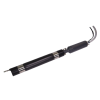Solinst Model 415 12V Submersible Pump Controller
Features
- Runs from 12V power source
- Convenient LED lights indicate pump status
- Easy-to-reset circuit breaker means no fuse to replace
- Free ground shipping
- Expedited repair and warranty service
- Lifetime technical support
- More
Overview
The Solinst 12V Submersible Pump Controller, when combined with the pump, is a lightweight and portable groundwater sampling system.
Mechanics
The Solinst Submersible Pump cable simply connects to the 12V Pump Controller, which then clips to a 12V power source. The 3/8" (9.5 mm) ID LDPE sample tubing is pushed onto the barbed fitting on the 12V Pump. It has an easy-to-reset circuit breaker (no fuse to replace). Simply turn the dial on the 12V Pump Controller clockwise to increase the voltage to the Controller, which turns the Pump’s motor faster and increases the flow rate.
Design
Convenient LED lights on the Controller indicate the status of the 12V Submersible Pump system, including high or low battery voltage, proper battery connection, normal operation and maximum flow rate.
Sampling Depth: As much as 36.5 m (120 ft) below ground surface
Flow Rates: Up to 13.5 L/min (3.6 US gpm)
Pump Cable Length: 130 ft (40 m)
Pump Cable Weight: 3.5 kg ( 7.8 lbs)
Wetted Materials: ABS pump body, 304 stainless steel motor, impeller and eyebolt, polypropylene hose barb, nitrile/buna o-rings and seals, PVC jacket electrical wire
Pump Size: 4.78 cm OD x 13.97 cm long (1.88" x 5.5")
Pump Weight: 0.8 kg (1.8 lbs)
Controller Size: 33 cm x 13 cm x 17 cm (13” x 5” x 6.5”)
Controller Weight: 3.4 kg (7.5 lbs)
Controller Cable Length: 1 m (3.5 ft)
Power Source: 12V Deep Cycle 60 amp AGM Battery or larger, or vehicle or marine battery.
Voltage Required: 12.5V–15V at source
Power Draw: 20mA (when dial is OFF), 3A (dial is at 1) to 36A (dial is at MAX (10))
Max. Run Time: Continuous, as long as Pump fully submerged during operation
Warranty: 12V Submersible Pump: 90 Days; 12V Pump Controller: 3 Years
In The News
Source Water Monitoring in Albany, New York: Tracing Water Quality throughout Tributaries
Thousands of US cities pull their drinking water from natural source waters like reservoirs, rivers, and streams, making overall watershed health a key consideration for water providers. In Albany, New York, the Albany Department of Water and Water Supply delivers drinking water to over 100,000 residents as well as monitors and manages the larger drinking water supply watershed. Hannah Doherty, Environmental Specialist at the Albany Department of Water and Water Supply , spends her days working with a small team to monitor the drinking supply and the connected water bodies. Doherty explains, “We’re the first to encounter the water that ends up being the drinking water.
Read MoreWildfire Prevention in the Sierra Nevada Region with the Yuba Watershed Institute
Though recent wildfires have sparked new conversations about wildfire management and response, groups like the Yuba Watershed Institute have been monitoring the forests and water resources of the Sierra Nevada region for decades, managing approximately 5,000 acres of land with the Bureau of Land Management (BLM) and about 7,000 acres in private land partnerships. The goal of the Institute is to work with local communities and land agencies to improve watershed and forestry management through informed practices and public outreach. The goals of the Yuba Watershed Institute are three-fold: Improve the ability of fire suppression agencies like the California Department of Forestry and Fire Protection ( CAL FIRE ) and the US Forest Service.
Read MoreWave Sensors Integration with NexSens Buoys: A Cutting-Edge Solution for Wave Measurment
Real-time wave data supports accurate weather prediction, safe and efficient maritime operations, and provides valuable safety and operating condition information for recreation and commercial fishing. Understanding wave dynamics also helps with the design of protective coastal structures like seawalls, breakwaters, and jetties. It also supports better prediction of their impact on sediment transport and coastal geomorphology. Wave data is a key factor in qualifying and designing offshore wind farms and harnessing kinetic energy for electrical generation. It helps with the understanding of ocean-atmosphere interactions and contributes to studies of sea-level rise and climate change impacts.
Read More















